
RESILIENT CURRENTS: ON COMMUNAL RE-EXISTENCE
Developed over the course of three years by independent curator Ilaria Conti, the exhibition Resilient Currents: On Communal Re-Existence, finds its home at the exhibition space of Thanks for Nothing, a nonprofit organization that serves as a hub for artists and actors of the art world to develop artistic and solidarity-driven projects with a major impact on society.
The exhibition shines a light on multidisciplinary practices linked to Abya Yala, a term from the Kuna culture symbolizing Central and South America as a constellation of sovereign, non-colonial, or decolonial spaces. The invited practices are committed to ethical forms of relation and epistemic justice—in one word, characterized by a commitment to the communal.
Resilient Currents explores the working methodologies employed by the presented artists who acknowledge the urgency of practicing political, social, affective, and spiritual forms of action as part of a network of ethical relationships. Rejecting the limits of colonial systems of knowledge, the artists honor the plurality of worlds that such a commitment to the notion of the communal generates.
The exhibition adopts a methodological approach that emphasizes artistic practices characterized by a dedication to communal values. Curator Ilaria Conti explains that this commitment to the communal involves a shared political agency and sensibility. Whether these practices are carried out individually or collectively, they acknowledge the interconnectedness that binds all beings and entities together.
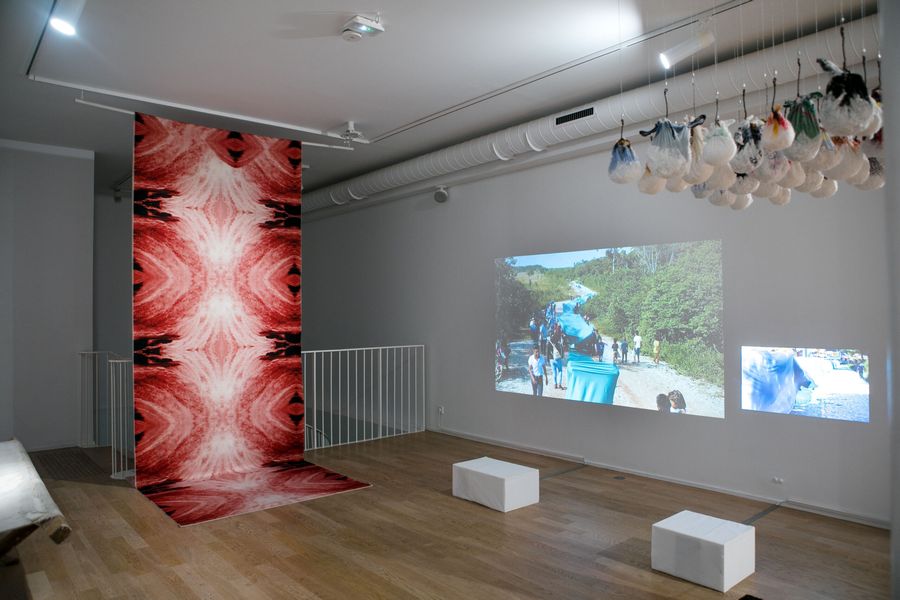

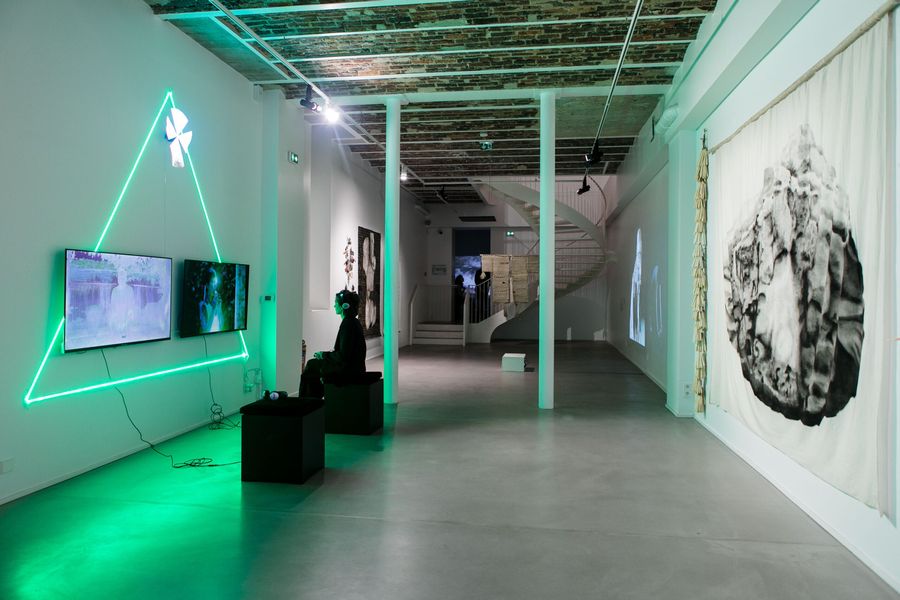
Conti further emphasizes that the artistic and activist practices showcased recognize the imperative to engage in various forms of political, social, affective, and spiritual agency within an interconnected web of ethical relations. These practices articulate diverse ways of knowing and sensing, grounded in the concept of «sentipensar» (sensing-thinking or feeling-thinking).
The artists reject the constraints imposed by colonial knowledge systems. Instead, they celebrate the multitude of worlds and the varied systems of understanding, sensing, and interpretation fostered by communal processes. In doing so, they engage in forms of resistance through re-existence, echoing the vision of Afro-Colombian theorist and artist Adolfo Albán Achinte, who describes it as «a form of life alter-active to the Eurocentric hegemonic project.»
Resilient Currents showcases works by Seba Calfuqueo, Carolina Caycedo, Colectivo Ayllu, Patricia Domínguez, Regina José Galindo, Sonia Gomes, Juliana Góngora, Jorge González Santos, iki yos piña narváez, Guadalupe Maravilla, Noé Martínez, Nomasmetaforas, Rangiñtulewfü, RojoNegro, Angélica Serech and María Sosa.

The Nomasmetaforas collective, formed by philosopher-pedagogue Clara Melniczuk and the artist Julian Dupont, works from contemporary art practices, pedagogies and spiral imagination. Committed to the indigenous knowledge of the Cauca region, their artistic practice is articulated in the activation of listening and reflection spaces that maintain a constant search to disarticulate the anthropocentrism to allow a multiple inhabiting beyond the human.
They currently work as dynamizers-pedagogues in the Intercultural Indigenous Autonomous University of the Indigenous Regional Council of Cauca, where they coordinate spaces of encounter and alliance between the arts and the pedagogies of Abya Yala, among them the residence The School of the Pluriverse, the sculptural space The House of Dreams, and the creation of a future pedagogical program in the UAIIN-CRIC linking the practices in contemporary art, philosophy, and traditional medicines.
Colectivo Ayllu, established in 2008 in Madrid by Latin-Americans practitioners Iki Yos Piña Narváez, Lucrecia Masson Córdoba, Francisco Godoy Vega, Kimy Leticia Rojas, and Alex Aguirre Sánchez describes itself as a «collaborative artistic-political research and action group comprised of migrant agents, racialized individuals, and sexual and gender dissidents from former colonies.»
Drawing inspiration from the Quechua concept of Ayllu, signifying a community or non-biological family, Colectivo Ayllu proposes a critique of white supremacy and European colonial heteronormative ideology.

For their part, the Rangiñtulewfü collective emerges from the diasporic journey of the Mapuche people, sharing this experience with those compelled to migrate within the confines of colonialism. They carry the memory of their mother tongue, Mapudungun, and from various historical territories, they extend their Wallmapu, embracing their identity as Mapuche and Champurrias.
The name of the collective, Rangiñtulewfü, which translates to «between rivers,» signifies its genesis in fracture, situated near Traitraiko, where the Cautín River converges—a symbolic location representing once-autonomous territory. The inclusion of «between» emphasizes the intertwining knot within this riverine bridge, representing their interstice.
“For our collective, it is important to tell history from our own perspectives. The case of Orélie-Antoine de Tounens (1825-1878), a Frenchman who after his arrival in Wallmapu (Mapuche territory) proclaimed himself ‘King of Araucania and Patagonia’ in 1860, is an example of how colonial expansionist logics affected (and continue to affect) Indigenous ancestral territories in geographical, historical, and political terms.”


Noé Martínez, Las Razones de mi nombre II, 2022, oil and Chinese ink on cotton paper. Courtesy: Collection of Rocío and Boris Hirmas
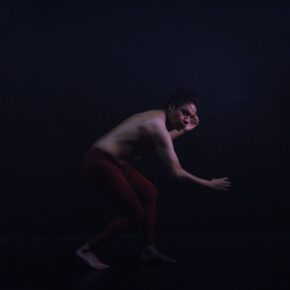


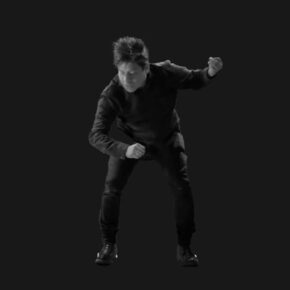
RojoNegro, “Habitar lo Oculto”, 2024, video stills. This work was commissioned by Thanks for Nothing for the exhibition. Courtesy of the artists
Another participating collective is RojoNegro [RedBlack], a duo whose artistic practice is grounded in research through the body, acknowledging their bodies as carriers of the histories of other bodies originating from specific geographies. The name of the duo refers to the cardinal points, each representing one member’s ancestral lineage.
«Black» symbolizes the West, representing María Sosa‘s Purépecha nation, while «Red» symbolizes the North, signifying Noé Martínez‘s Huastecan ancestors from the Huasteca of San Luis Potosí. Additionally, the name RojoNegro evokes the concept of sacred ink, as seen in vessels and codices adorned with red and black stripes, which delineate the universe’s boundaries, the division between the visible and invisible, and the layers of reality.
Mexican Nahua-Teenek artist Noé Martínez, originally from Michoacán (México), is a multidisciplinary creator with previous studies in political science. Whether it is drawing, installation or performance, he addresses issues such as transgenerational migration and the effects of colonization on the body politic of indigenous groups. Supported by ethnographic techniques and archival research, he does a kind of mapping and translation where he exhibits the processes of racialization about himself and the history of his people.
Also from Michoacán, María Sosa’s work is based on the exploration of research in the Ecology of Knowledge as well as the exploration of production techniques of pre-Hispanic and contemporary ritual objects. Her work reflects the search for the colonial past and the way in which it constitutes contemporary social events and dynamics.
The artist exhibits a piece from her series Xipe. To vindicate pre-Hispanic religious practices, settled in the collective imagination as witchcraft, Maria Sosa recovers the symbolism of renewal that circumscribes the Mexica god Xipe Totec, our flayed lord, drinker of blood, related to the rite of fertility and the advent of spring.
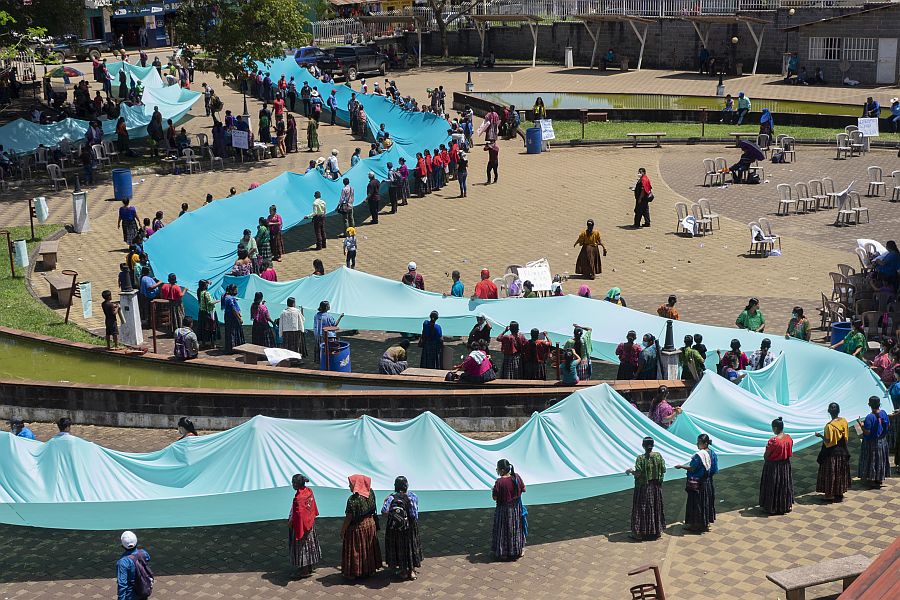
The show exhibits Ríos de Gente (2021), a collective happening led by Abelino Chub Caal and Regina José Galindo that remembered the places where a river once flowed, only to be diverted or polluted by the extractive industries that have stripped the indigenous peoples of Guatemala from their resources.
The Festival Libertad Para el Agua (Festival for the Liberty of Water) included the participation of over one thousand children, youth and adults from communities that have been affected by the activities in mining rigs, hydroelectric dams, and single crop farming by numerous transnational enterprises that operate with impunity in Guatemala.
In Ixcán (Quiché), Chisec (Alta Verapaz), El Estor (Izabal), Champerico (Retalhuleu) Monte Olivo (Cobán), San Juan Chamelco (Santa Rosa), amongst other places, people would scream: Liberty for the water, Liberty for Bernardo (Caal), We fight for life, We fight for water, Water is not merchandise, amongst other chants.


Jorge González, Ocamà Aracoel Roco Ku Guatu Nakan (Listen to the Ancestor, Remember the Sacred Fire Within), 2022-2024. Smoke dye on muslin. Courtesy of the artist and EMBAJADA, San Juan. Photographer: Pablo Rodríguez @pablor_d
Participating artist Jorge González Santos presents his piece Ocamà Aracoel Roco Ku Guatu Nakan (Listen to the Ancestor, Remember the Sacred Fire Within), which responds to historical omissions and forms of cultural and spiritual silencing by cultivating through his work communal processes meant to share and carry on Borikua (Puerto Rican) material and craft culture.
Jorge González Santos calls on Borikua (Puerto Rican) material culture in his practice to bridge Indigenous and modern ways of living and making. In response to the lack of everyday and academic knowledge and spaces for Borikua practices and history, in 2014, Santos established Escuela de Oficios, a space for collective learning and self-directed education. Its activities include mapping, documenting, and engaging in artisanal techniques, as well as a mobile program that includes conversations, workshops, and exhibitions.
Through these activities, distribution of knowledge — ranging from oral history, ancestral techniques, and collective practices — is articulated and shared with and among participants. From this approach, connections on self-managed education models are being explored, emphasizing convivial and communal forms of production.

In 2024, Thanks for Nothing initiates the program of its future Art and Solidarity Center, La Collective, scheduled to open in 2028 on the site of the former Hôpital Saint-Vincent-de-Paul. This ‘off-site’ program aims to showcase international socially engaged artistic practices.
The exhibition Resilient Currents: On Communal Re-Existence inaugurates this cycle, accompanied by a rich program of conferences, screenings, performances, and guided tours aimed at underserved audiences.
Conceived by Thanks for Nothing and Ilaria Conti, the associated program punctuates the exhibition with public programs involving partners organizations based in Paris, such as La Maison de l’Amérique latine, Persona Curada, and Mazorca.
In conjunction with the exhibition, Thanks for Nothing developed a solidarity program in support of the nonprofit organization AQUAVERDE. Founded in 2002, AQUAVERDE focuses its efforts on projects carried by populations indigenous to the Amazon Rainforest in support of their preservation. This biodiversity treasure remains a key component of global climate regulation and constitutes, together with the Amazon River and its tributaries, a quarter of the planet’s freshwater reserves.
RESILIENT CURRENTS: ON COMMUNAL RE-EXISTENCE
F O R M A exhibition center, 127 Rue de Turenne, Paris
March 21 – April 25, 2024
Works by Seba Calfuqueo (@sebacalfuqueo), Carolina Caycedo (@lacaycedo), Colectivo Ayllu (@colectivo_ayllu), Patricia Domínguez (@_patricia_dominguez_), Regina José Galindo (@galindoreginajose), Sonia Gomes (@soniagomesarte), Juliana Góngora, Jorge González Santos (@jigs_pr), iki yos piña narváez (@parchitapower), Guadalupe Maravilla (@guadalupe__maravilla), Noé Martinez (@radioimaginario), NOMASMETAFORAS (@nomasmetaforas), Rangiñtulewfü (@rangintulewfu), RojoNegro (@rojonegro.ome), Angélica Serech (@angelica_serech) and María Sosa (@maria_sosa_ruiz)
Guest curator: Ilaria Conti
Ilaria Conti’s work focuses on research-based artistic practices engaging with decoloniality and epistemic justice. Her practice is concerned with institutional infrastructures, communal care, curatorial ethics, labor, and civic agency. Currently, she serves as Executive Director and Chief Curator of La Nueva Fábrica, an exhibition and residency space in Antigua, Guatemala committed to empowering communities through contemporary art and social justice.
*
Featured image: Pedagogies of the Cosmomorphic Secret, Nine Color Lagoon, The Alps, France. Work by Julian Dupont presented in the context of the visit of the Indigenous Regional Council of Cauca to Paris in October 2022. Courtesy: Nomasmetaforas
También te puede interesar
GRITO PORQUE ESTOY VIVA. UNA ENTREVISTA A REGINA JOSÉ GALINDO
Con la obra "Las escucharon gritar y no abrieron la puerta", realizada en memoria a las víctimas del Refugio Virgen de la Asunción, arranca la revisión de los últimos 25 años de carrera de...
REGINA JOSÉ GALINDO: EL CANTO SE HIZO GRITO
En la obra de Regina José Galindo, el cuerpo femenino -vulnerable, marcado, pero vivo y combativo- típicamente retrata cómo los sistemas de opresión y violencia están arraigados en nuestras sociedades. Sus performances muestran la...
ANTI-FUTURISMO CIMARRÓN: IMAGINAR UN FUTURO QUE CAMINA HACIA EL PASADO
Cómo imaginar nuestra existencia sin Europa como proyecto de mundo fue la pregunta que en 2020 disparó el proceso teórico-artístico que culminó con la exhibición “Anti-futurismo Cimarrón” en el Centre Arts Santa Mònica y...



